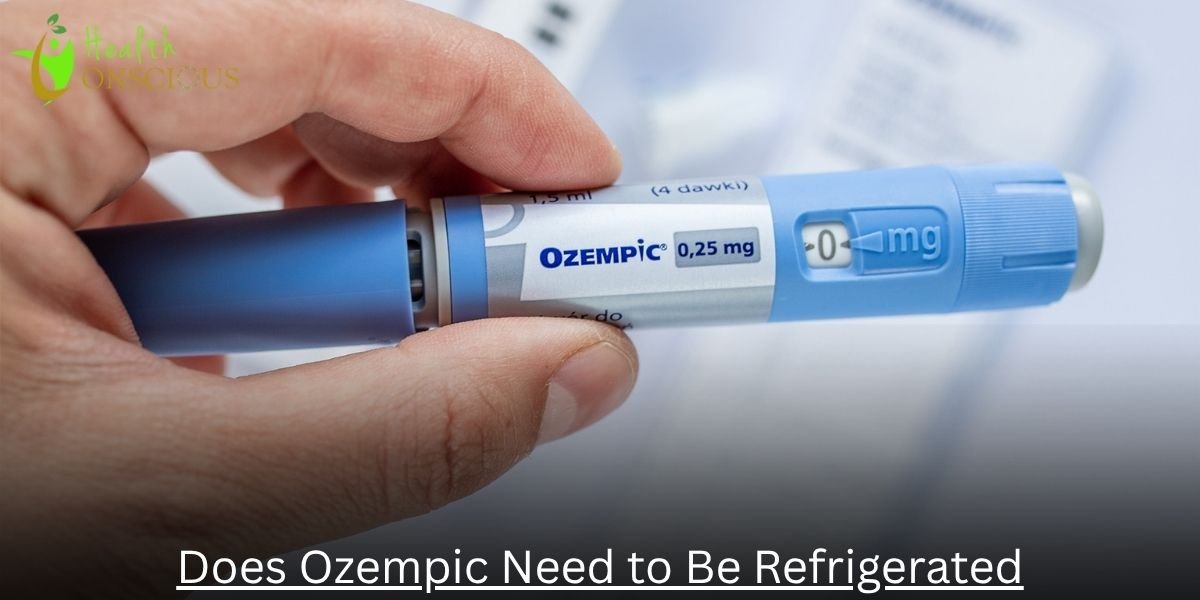Key Points
- Unopened Ozempic pens must remain refrigerated between 36°F and 46°F (2°C to 8°C)
- until they are either used for the first time or reach their expiration date.
- After opening, an Ozempic pen may be kept in the refrigerator or at room temperature below 86°F (30°C) for a maximum of 56 days.
- Never freeze Ozempic. If the medication has been frozen, it must be discarded immediately. Freezing compromises its effectiveness.
- Proper storage is crucial. It ensures the medication’s potency, helping it effectively manage blood sugar levels.
Introduction
Ozempic (semaglutide) is commonly prescribed to help control Type 2 Diabetes. Its effectiveness, like many injectable drugs, relies heavily on correct storage conditions, particularly temperature.
Understanding if Ozempic needs refrigeration and how to store it, especially during travel, is vital. This ensures your medication remains potent and safe for use.
What Is Ozempic Prescribed For?
Ozempic is an injectable prescription medication. It contains semaglutide, part of a class of drugs called GLP-1 receptor agonists.
It is primarily prescribed for adults with Type 2 Diabetes Mellitus. Its purpose is to improve blood sugar (glucose) control.
Ozempic works by mimicking a natural hormone, GLP-1. It helps release insulin in response to high blood sugar, reduces glucose output by the liver, and delays the emptying of food from the stomach.
People also use Ozempic for weight loss; however, Wegovy—which contains the same semaglutide in a higher dose—is the medication specifically recommended for treating obesity.
Along with managing blood sugar, Ozempic has approval to help reduce the risk of major heart-related complications. This includes heart attack or stroke, in adults with Type 2 Diabetes and established cardiovascular disease, as noted in its official prescribing information.
How Does Ozempic Come in the Pharmacy?
Ozempic is supplied as a clear, colorless solution. It comes in pre-filled, disposable, multi-dose pens for subcutaneous (under the skin) injection.
At the pharmacy, these pens are typically found in cartons. Each carton usually contains one or more pens, along with a set of needles. Each pen is designed for single-patient use.
Upon receiving Ozempic, it is crucial to immediately place any unopened pens into refrigeration. This method maintains their effectiveness and stability before they are used for the first time.
What Happens If Ozempic Is Not Refrigerated Before First Use?
If an unopened Ozempic pen is not refrigerated before its first use and is exposed to temperatures outside the recommended range (especially above 46°F or 8°C), its active ingredient, semaglutide, can degrade.
Semaglutide is a protein-based medication. Like many proteins, it is sensitive to temperature fluctuations.
Incorrect storage of the Ozempic pen before first use may result in reduced potency. This means the medication may not work as effectively to control blood sugar levels.
While it might not become harmful, its reduced efficacy could pose risks for individuals managing diabetes. According to manufacturer guidelines, if an unopened pen has been left unrefrigerated beyond acceptable limits or has been frozen, it should be discarded.
Does Ozempic Need to Be Refrigerated?
Yes, Ozempic needs to be refrigerated, but this requirement depends on whether the pen is unopened or already in use.
Before First Use (Unopened Pens)
Refrigeration is required for storing Ozempic pens that have not yet been opened. The recommended temperature range is 36°F to 46°F (2°C to 8°C). This ensures the medication remains stable and potent until its expiration date.
After First Use (Opened Pens)
Once an Ozempic pen has been opened and used for the first time, storage becomes more flexible. You can keep it refrigerated or at room temperature, depending on your storage preference.
Room temperature storage is acceptable provided it does not exceed 86°F (30°C). Regardless of where it is stored after first use, an opened pen must be used within 56 days (8 weeks). After this period, it should be discarded.
It is critical never to freeze Ozempic. Freezing causes irreversible damage to the medication’s molecular structure, making it ineffective even after thawing.
How to Travel with Ozempic?
Traveling with Ozempic demands careful preparation to maintain its effectiveness. Both the mode and duration of travel will influence storage considerations.
Carry-On Luggage for Air Travel
When traveling by air, keep Ozempic in your carry-on luggage, as temperature fluctuations in the cargo area can harm the medication.
The Transportation Security Administration (TSA) permits medically necessary liquids and injectables in quantities larger than 3.4 ounces in carry-on luggage. Carrying your prescription label or a doctor’s note is advisable for security checks, especially for international travel.
Temperature Control
For both air and car travel, consider an insulated bag or cooler with gel packs. This is necessary if transporting an unopened pen, or if the trip duration exceeds the 56-day room temperature limit for an opened pen.
Ensure the Ozempic pen does not directly touch ice or freezing gel packs, which could cause it to freeze. A cloth or bubble wrap barrier can help prevent direct contact.
Avoid Extreme Temperatures
Whether in a car or outdoors, never leave Ozempic in direct sunlight. Avoid hot cars (e.g., glove compartment or dashboard) or unheated areas in cold weather. High heat degrades semaglutide, and freezing destroys it.
Upon Arrival
As soon as you arrive at your destination, place any unopened Ozempic pens in the refrigerator without delay.
How Long Can Ozempic Be Out of the Fridge?
The safe duration for Ozempic outside of refrigeration depends on its status.
Unopened Pens
An unopened Ozempic pen should be kept in the fridge until it’s time for the first use. Brief excursions to room temperature (e.g., transport from pharmacy to home) are generally tolerated.
However, prolonged exposure (e.g., several days or weeks) outside refrigeration before first use is not recommended by the manufacturer. If an unopened pen is exposed to temperatures above 46°F (8°C) for an extended period, particularly above 86°F (30°C), its stability cannot be guaranteed, and it should be discarded.
Opened Pens (After First Use)
After initial use, the Ozempic pen may be stored at room temperature. This is permissible as long as the temperature remains below 86°F (30°C).
An open pen remains effective for up to 56 days, regardless of whether it’s kept refrigerated or at room temperature. Once this time has passed, dispose of the pen, even if some medicine is left.
How to Store Ozempic? Unopened & Opened
Proper storage is fundamental to maintaining Ozempic’s efficacy. Adhering to manufacturer guidelines ensures the medication delivers its intended therapeutic benefits.
Unopened Ozempic Pens
- Refrigeration is Mandatory: Unused Ozempic pens must be stored in the refrigerator, with temperatures ranging from 36°F to 46°F (2°C to 8°C).
- Protect from Light: Keep the pens in their original carton to shield them from light exposure.
- Do Not Freeze: Freezing can permanently damage the medication. Do not use Ozempic if it has been frozen; throw it away immediately.
- Until Expiration Date: When properly refrigerated, unopened pens are valid until the expiration date printed on the label.
Opened (In-Use) Ozempic Pens
- Flexible Storage: Once in use, the pen may be stored either in the fridge (36°F to 46°F / 2°C to 8°C) or at room temperature, as long as it stays below 86°F (30°C).
- 56-Day Limit: Regardless of storage location, an opened Ozempic pen is stable for 56 days (8 weeks) after its first use. After the recommended usage period, the pen should be discarded, even if it still contains medication.
- Protection: Ensure the cap remains on the pen when not in use to guard against light exposure. Also, shield it from excessive heat and direct sunlight.
- No Freezing: Even an opened pen must never be frozen.
Things to Check Before Using the Ozempic Pen
Before each injection, inspect your Ozempic pen. This helps keep the medicine both safe and effective for administration.
- Appearance: Use the pen only if the solution is clear and colorless. Avoid using it if it’s cloudy, has discoloration, or visible particles. Such changes can indicate potency loss or contamination.
- Freezing: Confirm the pen has not been frozen. If you suspect freezing (e.g., unusually cold, crystallized appearance, altered consistency after thawing), discard it.
- Expiration Date: Confirm the expiration date on the box or pen. Use unopened pens before the marked date, and make sure opened pens are used within 56 days from first use.
- Physical Damage: Inspect the pen for any signs of physical damage, such as cracks or leaks. A damaged pen might not deliver the correct dose or could leak.
- Temperature Acclimation (Optional for Comfort): If storing your opened pen in the refrigerator, you may allow it to warm to room temperature. Waiting around 15 to 30 minutes before injecting may help ease discomfort. Do not forcefully heat the pen.
Final Remarks
Adhering to Ozempic’s specific storage and travel guidelines is paramount. This ensures the medication’s effectiveness and your safety.
Semaglutide, its active ingredient, is delicate. It can degrade under improper conditions, potentially leading to suboptimal blood sugar control.
Always prioritize proper refrigeration for unopened pens. Be mindful of the 56-day stability period once a pen is in use.
If you have any doubts about your Ozempic pen’s integrity due to temperature exposure or its appearance, contact your pharmacist or healthcare provider. They can provide personalized advice and help ensure your diabetes management remains on track.



